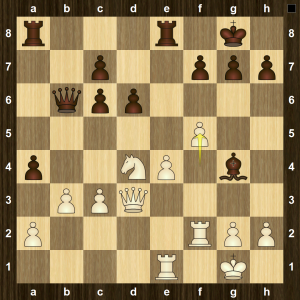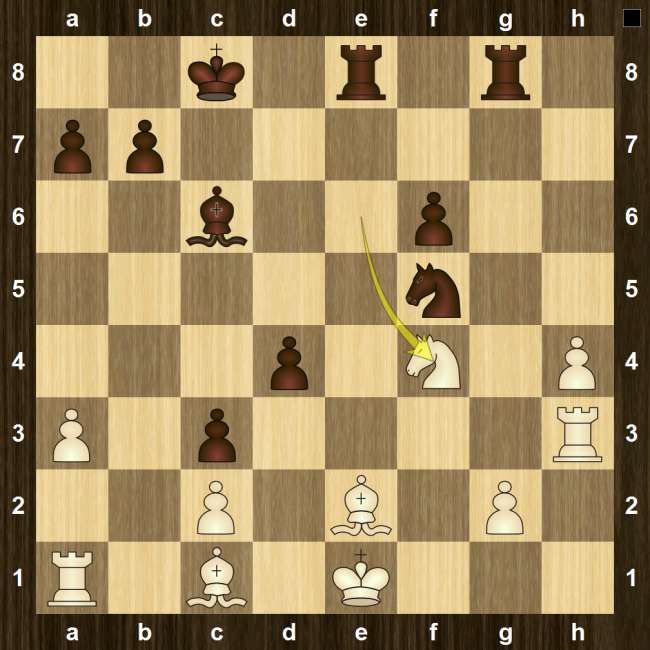I hadn’t played a tournament since May, when I had a disastrous tournament and lost four games before withdrawing in disgust. My tournament this weekend was mostly mediocre, except for one game, in which I scored my first win against an IM. (It was a useful moment to start playing like a master myself.) Naturally, that’s the one I’m going to show.
Simon Rubinstein-Salzedo (2060) vs. IM Ray Kaufman (2354)
1. e4 e5 2. Nf3 Nc6 3. d4 exd4 4. Nxd4 Nf6 5. Nxc6 bxc6 6. Bd3
Previously, I had played the main line of the super-sharp Mieses variation of the Scotch, which goes 6. e5 Qe7! (not Nd5) 7. Qe2 Nd5 8. c4 and black plays either 8…Nb6 or 8…Ba6. The game could continue something like this. However, this is the sort of game I’d rather watch than play, being a Boring Positional Player and all that.
So, the quieter and more civilised 6. Bd3 line suits me better and allows me not to memorize gobs of theory, although objectively it offers white somewhat fewer prospects.
6…d6
This move surprised me. I usually see 6…d5, after which I would continue with 7. exd5, since after 7. e5 Ng4 8. 0-0 Bc5, black is going to be the one who has more fun for a while. Here’s the sort of thing that can go wrong for white. But after 7. exd5, white is slightly better, since eir pawn structure is slightly better.
7. O-O Be7 8. Qe2
Okay, 8. Nc3 is more natural (and more common), but I am not yet sure how I want to develop my queenside pieces: do I put my bishop on g5, or on b2? Do I develop the knight to c3 or d2? If c3, should I play c4 first? But I am certain that I will have to move my queen out at some point, so I might as well do that now and think more about what to do about the rest of my pieces.
8…O-O 9. b3 Nd7!
A very sensible redevelopment. My opponent is planning to play Bf6 next move (whether I play Bb2 or not) and later plant the knight on c5 or e5, where it’s sort of annoying.
10. Bb2 Bf6 11. Bxf6 Qxf6 12. Nd2 Re8 13. f4 Nc5 14. Rae1 Qc3
I think both sides can be relatively satisfied with this position. It’s about equal, and there isn’t anything obvious that either side has to do, so we can just play chess and try to come up with the best ideas we can.
15. Nf3 a5
Okay, so his plan is to weaken my queenside pawns or else open the a-file for his rook. Very sensible. Playing 16. a4 felt wrong, since after 16…Nxd3 17. Qxd3 Qxd3 18. cxd3 Rb8, I’ve given my opponent a target for no good reason. One possibility (depending on where the queens are at the time) is to play b4 after black plays a4 and then follow up with a3 (unless black plays it first). Then we each have a bunch of structural weaknesses that probably balance out. Another option (which the computer recommends) is to play e5 and focus on black’s c-file weaknesses. The position remains balanced.
16. Qd2 Qb4
I’d be satisfied with exchanging queens on d2, but not on b4.
17. c3 Qb6
Not 17…Qa3? 18. Bb1!, and after an eventual e5, the white bishop will be a very dangerous piece.
18. Rf2
But not 18. Kh1? when after 18…a4! I don’t have a satisfactory way of dealing with Nxd3 and Ba6.
18…Bg4

Really? That way? I was mostly expecting the bishop to move out to a6 or b7 at some point.
19. Nd4
Aside from the fact that I don’t want to allow him to capture on f3 and slightly damage my kingside pawns (which wouldn’t be too big of a problem), this introduces some interesting tactical possibilities in the next few moves.
19…Nxd3 20. Qxd3 a4
It looks like black is making progress on the queenside. But there’s a small problem.
21. f5!
Suddenly the bishop is in serious danger of getting trapped. The only way out is to play f6 followed by Bh5 and Bf7. Note that the move order is very important: After 21…Bh5? 22. Qh3! g6 23. g4 wins the bishop.
21… axb3!
Unbelievable! He’s just going to let me trap his bishop? Yes, because if I start to trap it with 22. h3, then after 22…bxa2 23. Ra1 c5 24. Nc2 Qb1 25. Rf1 c4 26. Qd2 Qb6 27. Kh1 Bh5 28. g4 Bxg4 29. hxg4, black has lots of compensation for the piece and is better (but possibly not winning). Of course, I didn’t see the whole line, but I saw enough to realize that it was sensible to stabilize the queenside before dealing with the bishop.
22. axb3! c5?
There’s no need to help me reroute my knight to a better square. Now white is substantially better.
Just a few moves ago, we had a relatively quiet position, where it seemed hard for either side to make any seriously dangerous threats. Now the position is very sharp, and seemingly minor inaccuracies like c5 can be fatal.
23. Nc2!
23. Nb5 was briefly tempting, but my move helps the knight get to the square it actually wants to reach: d5.
23…f6?
Of course, I was expecting this move, but it runs into tactical problems…that I completely overlooked. Better was to sacrifice the bishop with 23…Qxb3, which gives black some compensation for the piece, but probably not enough.
24. Ne3?
Looks sensible, but after 24. Qc4+! black is in serious trouble and possibly just lost. The obvious move 24…Kh8? just loses to 25. Ne3!, when the bishop is lost for very little compensation. Better is 24…Kf8, but after 25. e5!, black’s problems continue: 25…Bh5? loses outright to 26. e6, but after 25…Rxe5 26. Rxe5 dxe5 27. Qxg4 Qxb3, black can muddle on. Instead, the computer’s choice is 24…d5, but white just captures with the queen and is up a pawn for no compensation.
After my mistake, black is okay again. At least, in theory: in practice, white’s position is much easier to play.
24…Bh5 25. Nd5 Qb7 26. Qg3!
No more messing around; it’s time to attack the king.
26…Kh8
I was expecting this move, but 26…Kf8 avoids some of black’s later problems. I suppose he missed or underestimated my 28th move.
27. Qh4 Bf7?
What else is he supposed to do? 27…c6! Then after 28. Nxf6 gxf6 29. Qxh5 Qxb3, the position is equal. Now white is winning.
28. Nxf6!
This is just winning. I wasn’t so confident during the game, but I couldn’t find a satisfactory defense for black, so I had to play it. But on the other hand, what am I doing!?!?! I’m supposed to be a Boring Positional Player; why am I sacrificing my pieces? (And why does this happen in quite a few of the games I have annotated on my blog recently?)
28…gxf6 29. Qxf6+ Kg8 30. Rf4
The computer tells me that 30. Rf3 is even stronger. Whatever.
30…h5
30…Qxb3 puts up a bit more resistance, but it’s still lost.
31. Qh6
New mate threat: f6 and Qg7.
31…c6 32. Rf3 h4 33. Rf4 Black resigns
Of course, I’m thrilled with the result of this game, but I’m also quite satisfies with the game itself. It was one of the most interesting games I’ve played, and I’m happy with how I played, even if I did miss a very powerful move on move 24.
I’m hoping this is only the first of many wins over masters on my quest of chess improvement.
























